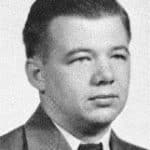In spring 1951, just after Magnolia A&M College became Southern State College (SSC), music major Hugh Canterbury mulled over Band Director Richard Oliver’s assignment— compose a piece of original music. At the time, the SSC band played the A&M “Loyalty Song.”
The tradition of lyrically expressing loyalty to colleges originated in 18th century England. There, alma mater (Latin for “fostering mother”) first referred to schools venerated in poems and songs.
Magnolia A&M’s “Loyalty Song” was written in 1927 by Harriet Key, the first women’s physical education instructor. Her sister, Louise, a student at Harvard College, influenced the melody: the A&M tune, like Harvard’s, came from the Irish air “Believe Me, If All Those Endearing Young Charms.”
Key’s lyrics echoed those of the “Alma Mater” of A&M’s ancestor, the Third District Agricultural School (TDAS). Student editor John McDaniel’s verses in the 1916 yearbook employed as a refrain “The Blue and the Gold.” Key’s “Loyalty Song” also honored the school colors as she celebrated A&M.
In 1914, A. C. Maddox, a math instructor, had penned TDAS’s first short-lived song. Students and alumni did sing “Dear Aggie School” to the tune of “America, the Beautiful” at the first “Homecoming” on Thanksgiving Day in 1915.
In 1951, Hugh Canterbury decided to compose a new “Alma Mater” for SSC. Canterbury’s friend Lewis Gardner helped with lyrics. They did not retain the blue and gold theme of earlier songs. One-third of their lyrics came from the “Alma Mater” of Southeast Louisiana College. Magnolia natives Canterbury and Gardner had attended that school before returning home.
Canterbury’s melody was influenced by the “Navy Blue and Gold,” the U.S. Naval Academy’s school song. The first three and a half bars and most of the third phrase of SSC’s “Alma Mater” are the same as Navy’s. As a youngster, Canterbury may have heard the midshipmen’s tune in two popular movies before the Second World War. But he did not consciously copy the song.
SSC’s blue and gold school colors had originated with its founders. In 1909, members of the Farmers’ Educational and Cooperative Union had proudly carried their blue and gold union banners as they successfully lobbied Arkansas’s legislature to create TDAS and three sister schools. Was it ghosts of the Farmers’ Union, who still haunt SAU’s campus, that would not allow Canterbury to compose a new “Alma Mater” without the blue and the gold, even if only indirectly in melody?
Almost unchanged, SSC’s “Alma Mater” became that of Southern Arkansas University. To make it easier for students and alumni to sing, Richard Oliver arranged a simple version in the key of F, although the choir still performed the original in the key of G. A typing error in the 1967-68 student’s Mulerider Guide changed the original lyrics’ “O Southern State” to “oh,” a mistake that needs correction. In 1976 when SSC became SAU, it was probably Dr. Robert Campbell, music department chair, who changed the song’s first line: “We hail thee now oh Southern State” became “We hail thee now oh SAU.”
- Magnolia A&M’s Alma Mater, titled “Loyalty Song” (Click on photo to enlarge)
- “Fair Harvard,” Harvard College’s Alma Mater (Click on photo to enlarge)
- “Alma Mater,” TDAS’s second Alma Mater (Click on photo to enlarge)
- “Dear Aggie School,” TDAS’s first Alma Mater (Click on photo to enlarge)
- Hugh Canterbury (Click on photo to enlarge)
- Lewis Gardner (Click on photo to enlarge)
- Southeast Louisiana College’s Alma Mater (Click on photo to enlarge)
- The Naval Academy’s Alma Mater, titled “Navy Blue and Gold” (Click on photo to enlarge)
- SSC’s “Alma Mater,” composed by Canterbury and Gardner (Click on photo to enlarge)









